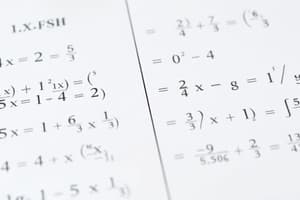Podcast
Questions and Answers
What determines the end behavior of a polynomial function?
What determines the end behavior of a polynomial function?
- The degree and leading coefficient of the polynomial (correct)
- The number of turning points
- The zeros and their multiplicities
- The coefficients of all terms in the polynomial
Which statement about turning points in a polynomial of degree n is true?
Which statement about turning points in a polynomial of degree n is true?
- Turning points occur only at the zeros of the polynomial.
- Turning points can be any number less than or equal to n.
- A polynomial of degree n must have n-1 turning points.
- There can be at most n turning points. (correct)
Which method is essential when simplifying rational expressions?
Which method is essential when simplifying rational expressions?
- Isolating variables in the expressions
- Identifying the highest common factor
- Applying logarithmic properties
- Factoring the numerator and denominator (correct)
What is the first step in solving a radical equation?
What is the first step in solving a radical equation?
What function is the inverse of the exponential function f(x) = a^x?
What function is the inverse of the exponential function f(x) = a^x?
What is the standard form of a quadratic equation?
What is the standard form of a quadratic equation?
What does a positive discriminant indicate for a quadratic equation?
What does a positive discriminant indicate for a quadratic equation?
What is the primary purpose of the quadratic formula?
What is the primary purpose of the quadratic formula?
How can a quadratic inequality be solved graphically?
How can a quadratic inequality be solved graphically?
Which theorem indicates that a polynomial function has as many roots as its degree, considering multiplicities?
Which theorem indicates that a polynomial function has as many roots as its degree, considering multiplicities?
What is the first step in completing the square for a quadratic equation?
What is the first step in completing the square for a quadratic equation?
In polynomial functions, what does the degree indicate?
In polynomial functions, what does the degree indicate?
What does the Factor Theorem state about a polynomial P(x) and a linear factor (x - c)?
What does the Factor Theorem state about a polynomial P(x) and a linear factor (x - c)?
Flashcards
End Behavior
End Behavior
The behavior of a polynomial's graph as x approaches positive or negative infinity.
Turning Points
Turning Points
Points on a polynomial graph where the function changes direction (from increasing to decreasing or vice-versa).
Rational Expression
Rational Expression
A fraction where both the numerator and denominator are polynomials.
Rational Equation
Rational Equation
Signup and view all the flashcards
Radical Expression
Radical Expression
Signup and view all the flashcards
Quadratic equations
Quadratic equations
Signup and view all the flashcards
Factoring quadratic equations
Factoring quadratic equations
Signup and view all the flashcards
Quadratic Formula
Quadratic Formula
Signup and view all the flashcards
Discriminant
Discriminant
Signup and view all the flashcards
Quadratic inequalities
Quadratic inequalities
Signup and view all the flashcards
Polynomial functions
Polynomial functions
Signup and view all the flashcards
Degree of a polynomial function
Degree of a polynomial function
Signup and view all the flashcards
Factor theorem
Factor theorem
Signup and view all the flashcards
Study Notes
Quadratic Equations
- Quadratic equations are polynomial equations of the second degree. They are typically written in the form ax² + bx + c = 0, where a, b, and c are constants, and a ≠ 0.
- Solutions to quadratic equations can be found using various methods, including factoring, completing the square, and the quadratic formula.
- Factoring involves expressing the quadratic as the product of two linear factors. This method is often the fastest if the quadratic factors easily.
- Completing the square involves manipulating the equation to isolate the squared variable and take the square root of both sides to solve for the unknown.
- The quadratic formula, x = (-b ± √(b² - 4ac)) / 2a, provides a general solution for any quadratic equation.
- The discriminant (b² - 4ac) determines the nature of the roots:
- Positive discriminant: Two distinct real roots.
- Zero discriminant: One real root (a repeated root).
- Negative discriminant: Two complex conjugate roots.
Solving Quadratic Inequalities
- Quadratic inequalities involve comparing a quadratic expression to zero. The solutions generally include an interval on the number line.
- To solve quadratic inequalities graphically, one would find the x-intercepts of the corresponding quadratic equation, and analyze the sign of the parabola on different intervals.
- To solve algebraically, factor the quadratic if possible, and determine the values of x that make the expression positive or negative. The intervals determined by the roots of the equation play a key role.
Polynomial Functions
- Polynomial functions are functions that can be written in the form P(x) = anxn + an-1xn-1 + ... + a1x + a0, where the exponents are non-negative integers and the coefficients (ai) are constants.
- The degree of a polynomial function is the highest power of x in the expression. This determines the general shape and behavior of the graph.
- The fundamental theorem of algebra states that every polynomial equation with complex coefficients has at least one complex root. This implies that every polynomial of degree n has n complex roots, counting multiplicities.
- The Remainder Theorem states that if a polynomial P(x) is divided by (x - c), the remainder is P(c).
- The Factor Theorem states that (x - c) is a factor of P(x) if and only if P(c) = 0.
Polynomial Graphing
- Graphing polynomial functions involves analyzing the degree, the leading coefficient, the zeros and their multiplicities.
- The end behavior of a polynomial is determined by the degree and the leading coefficient.
- Turning points are the locations where the graph changes from increasing to decreasing or vice-versa. There can be at most n-1 turning points for an nth-degree polynomial.
- Knowing the zeros, their multiplicities, and the end behavior gives a good sketch of the graph.
Rational Expressions and Equations
- Rational expressions involve fractions where the numerator and denominator are polynomials.
- Operations on rational expressions include addition, subtraction, multiplication, and division.
- Simplifying rational expressions typically involves factoring the numerator and denominator and canceling common factors.
- Solving rational equations involves identifying restrictions on the variables to avoid division by zero, and then manipulating the equation to eliminate the denominators.
Radical Expressions and Equations
- Radical expressions include terms with radicals (square roots, cube roots, etc.).
- Simplifying radical expressions often involves using rules of exponents and radicals to reduce the expression to its simplest form.
- Solving radical equations generally entails isolating the radical term, squaring both sides of the equation (or raising both sides to the appropriate power), and then solving the resulting equation. It is important to check solutions, as extraneous solutions can sometimes arise.
Exponential and Logarithmic Functions
- Exponential functions have the form f(x) = ax, where a is a positive constant (the base) and x is any real number.
- Logarithmic functions are the inverses of exponential functions. They have the form y = loga x.
- Properties of logarithms are essential for simplifying and evaluating logarithmic expressions, including the change of base formula.
- Exponential and logarithmic functions are crucial in various applications, including exponential growth and decay, and solving equations involving exponents.
Studying That Suits You
Use AI to generate personalized quizzes and flashcards to suit your learning preferences.




